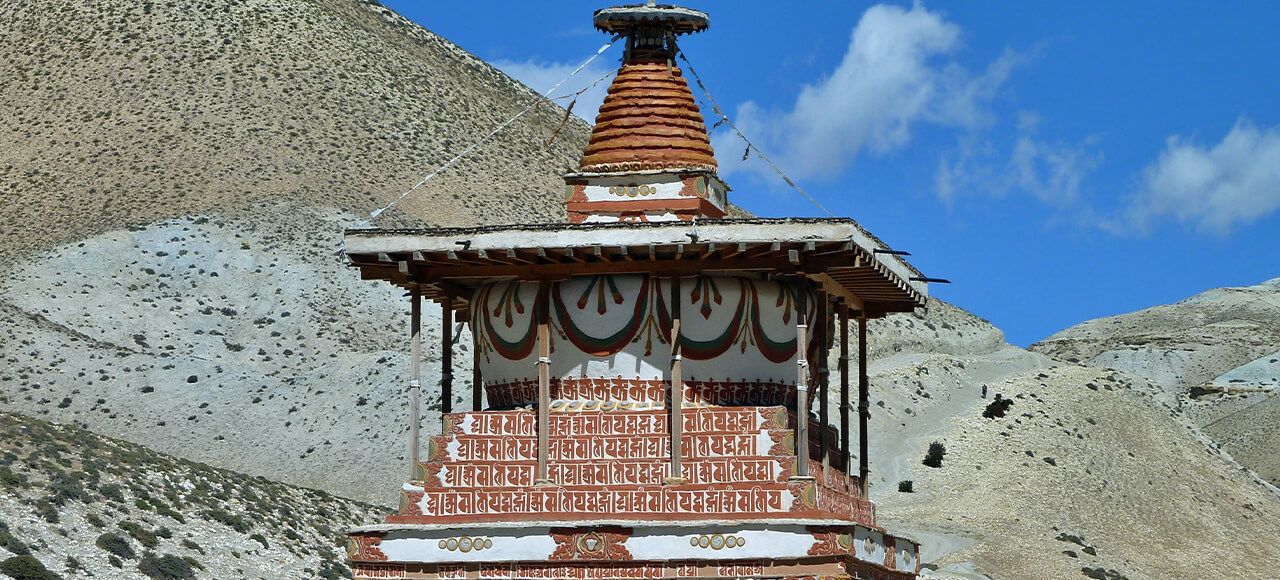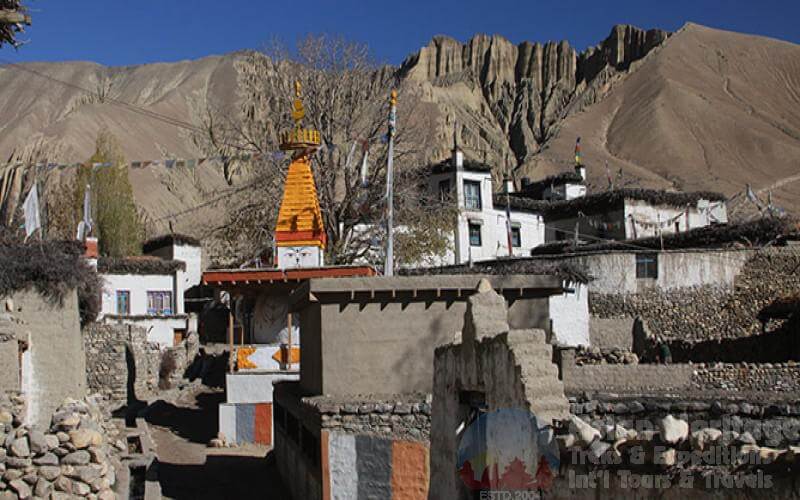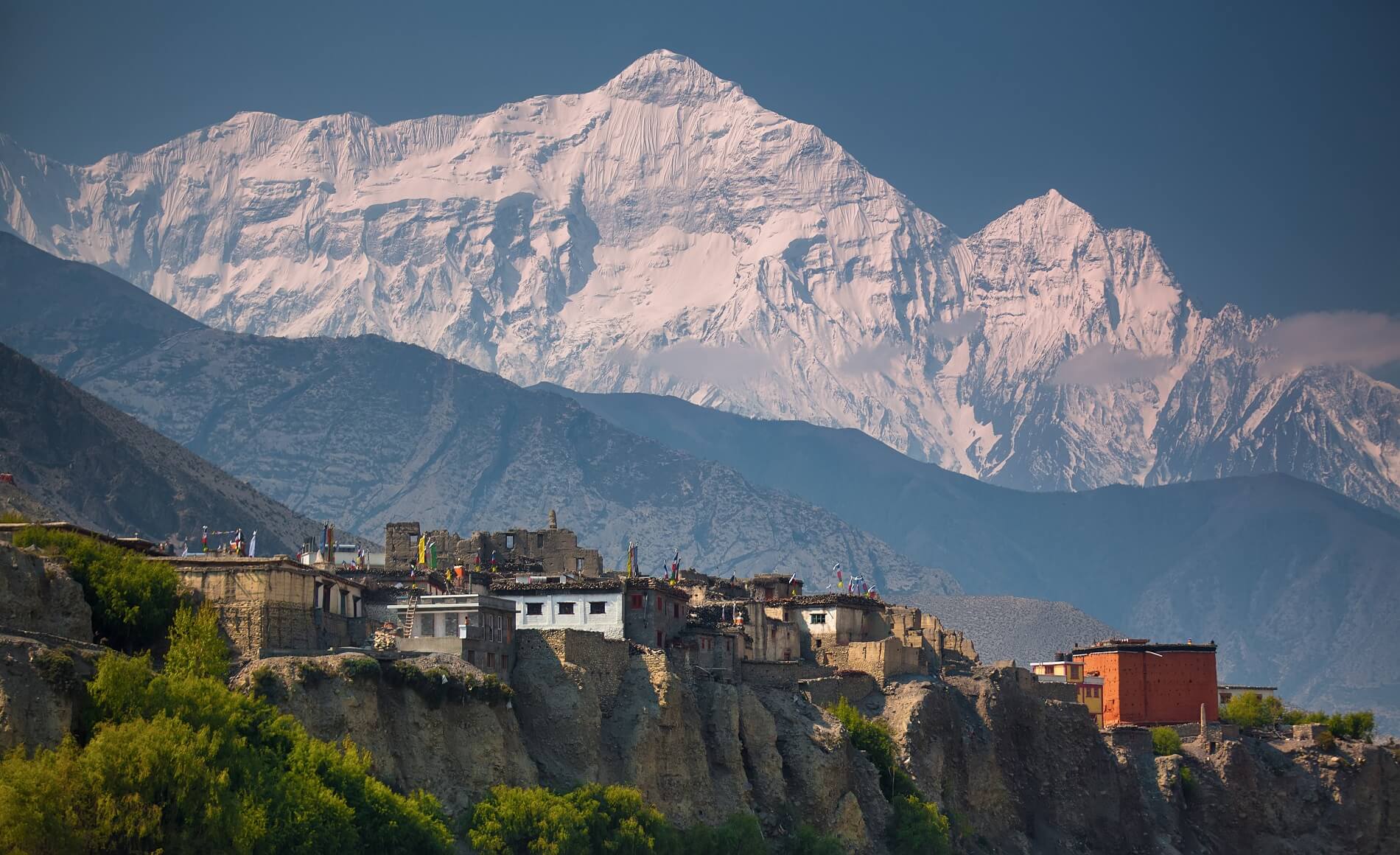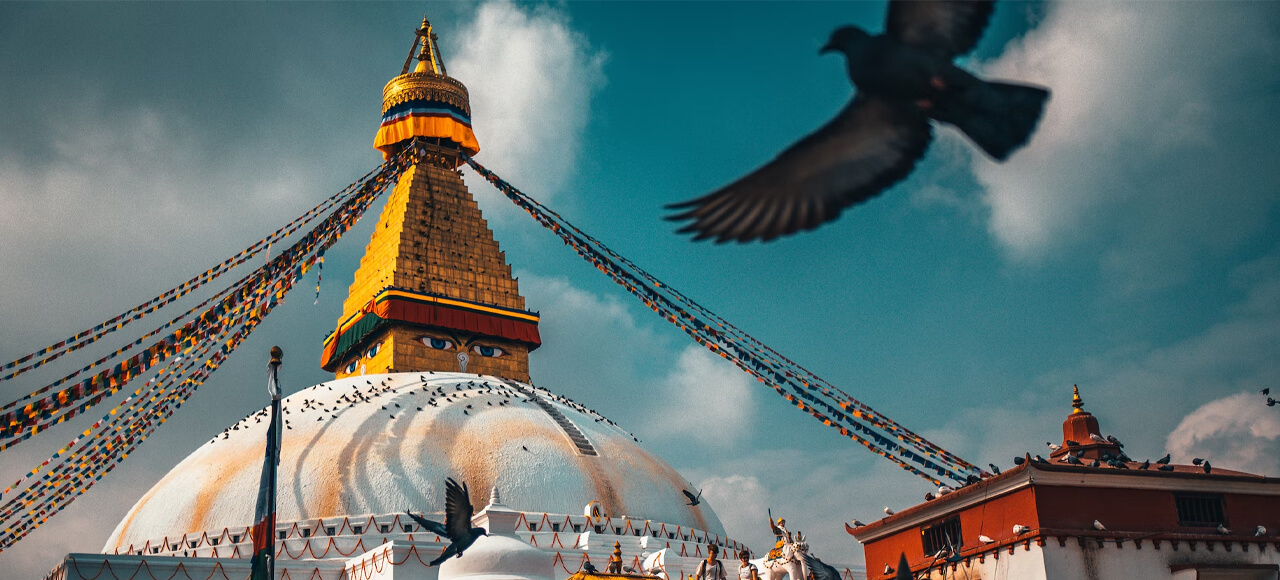Welcome to the Upper Mustang Trek in December, a journey that will ignite your curiosity and leave you in awe of the region’s breathtaking natural beauty and cultural treasures.

Get ready for an adrenaline-fueled adventure as we travel over snow-covered paths, negotiate challenging gorges, and uncover secret monasteries in one of Nepal’s most alluring and forbidden locales. Due to the harsh weather conditions, December is considered the off-season for tourism in Upper Mustang. However, if you are prepared for the cold temperatures and are seeking a unique and less crowded experience, this can be a rewarding time to visit.
Weather condition and Temperature of Upper Mustang in December
In December, Upper Mustang experiences cold and dry weather conditions due to its location in the Himalayas region of Nepal. Upper Mustang, formerly known as the “Kingdom of Lo,” lies in the rain shadow of the Annapurna and Dhaulagiri mountain ranges, resulting in limited precipitation throughout the year.
In December, Upper Mustang is in the midst of winter, and the temperatures can be quite chilly. During the day, the average temperatures range from approximately 0 to 5 degrees Celsius (32 to 41 degrees Fahrenheit). However, during the nighttime, the temperatures drop significantly, often plunging below freezing point. It is not uncommon for the temperatures to reach -20 degrees Celsius (-4 degrees Fahrenheit) or even lower, particularly in higher elevations and remote regions. The region experiences clear skies and sunny days for the most part. Snowfall is infrequent but can occur, particularly at higher altitudes.
Highlights of Upper Mustang Trek in December
The Upper Mustang trek in December offers a unique and mesmerizing experience, showcasing the rich cultural heritage and stunning landscapes of the Mustang region in Nepal.
Here are some highlights of the trek during this time:
Isolated and Trans-Himalayan Experience
Upper Mustang is a restricted area that allows limited access, preserving its untouched beauty and cultural heritage.

Trekking in December ensures a quieter experience as it is the off-peak season, offering a sense of solitude and tranquility.
Unique Cultural Exploration
Upper Mustang is known as the “Last Forbidden Kingdom” of Nepal, and it boasts a distinct Tibetan–influenced culture. You can visit ancient monasteries, caves, and traditional villages that have preserved their traditions for centuries. December allows you to witness the daily lives and rituals of the local people, who follow a unique blend of Tibetan Buddhism.
Spectacular Mountain Views
The trek offers breathtaking views of the Annapurna and Dhaulagiri mountain ranges, including their snow-capped peaks.

The winter months often bring clear skies, providing excellent visibility for stunning panoramic vistas and majestic sunrises and sunsets.
Cultural and Natural Highlights
The Upper Mustang trek showcases an incredible variety of landscapes, ranging from barren cliffs and rugged canyons to expansive valleys adorned with colorful prayer flags. You’ll cross the Kali Gandaki River, walk through the charming villages of Kagbeni, Charang, and Lo Manthang, and explore ancient cave dwellings and monasteries like the Luri Gompa and Chhoser Cave.
Warm Local Hospitality
Despite the cold weather, the locals of Upper Mustang are known for their warmth and hospitality. December offers an opportunity to interact closely with the locals as the tourist influx is significantly lower during this time. You can engage in conversations, learn about their unique lifestyle, and even participate in cultural activities.
The crowd in Upper Mustang in December
December is a relatively dry time to visit. One of the most noticeable aspects of trekking in Upper Mustang during the December off–season is the limited number of tourists. Unlike the peak months, when the trails are bustling with trekkers, December offers a quieter and more serene experience. During the off-season, you might encounter only a handful of fellow trekkers on the trail, creating a sense of solitude and exclusivity. The trails, which are usually teeming with people during the peak season, offer a peaceful and meditative atmosphere. You can enjoy the breathtaking vistas of barren desert-like landscapes, ancient cave dwellings, and towering Himalayan peaks in tranquility.
Kathmandu to Upper Mustang

To travel from Kathmandu to Upper Mustang in December, you typically need to follow these steps:
By Flight
Take a local aircraft from Kathmandu to Pokhara to begin your adventure. There are several airlines that provide daily flights between these two cities; the trip takes about 25 to 30 minutes. You’ll need to get to Jomsom, which is where you can access Upper Mustang, from Pokhara.
A domestic flight is available from Pokhara to Jomsom. The flights are subject to weather conditions and last for around 15–20 minutes. It’s important to keep in mind that flights occasionally get canceled or delayed in mountainous areas owing to bad weather, so it is advisable to plan your trip with some flexibility.
If weather conditions or flight availability are not favorable, an alternative option is to travel by road from Pokhara to Jomsom. This journey takes approximately 8–10 hours by jeep or bus. The road can be bumpy and challenging in certain sections, so be prepared for a potentially long and arduous ride.
Trek to Upper Mustang
Once you reach Jomsom, you can begin your trek to Upper Mustang. The trekking duration and itinerary can vary depending on your preferences and the time you have available. It typically takes around 7–10 days to reach Lo Manthang, the main town in Upper Mustang, and another 7-10 days for the return trek.
Required Permits for Upper Mustang
The Upper Mustang Trek is a restricted area trek in Nepal, which means that certain permits are required to trek in this region. Here is detailed information about the permits required for the Upper Mustang Trek:
Annapurna Conservation Area Permit (ACAP)
The Annapurna Conservation Area Permit (ACAP) is required for all treks in the Annapurna region including the Upper Mustang Trek. The ACAP is issued by the Annapurna Conservation Area Project (ACAP) office in Kathmandu or Pokhara. The cost of the permit is NPR 3,000 (approximately USD 25) per person.
Restricted Area Permit (RAP)
The Upper Mustang region is a restricted area, and therefore, a Restricted Area Permit (RAP) is required to enter this region. The RAP is issued by the Department of Immigration in Kathmandu and is only available for purchase through a registered trekking agency. The RAP is valid for a maximum of 10 days and costs USD 500 per person for the first 10 days, and USD 50 per person for each additional day.
TIMS CARD
A Trekkers‘ Information Management System (TIMS) card is a mandatory permit required for all trekkers in Nepal. The TIMS card provides information on trekkers and helps maintain a database of trekking activities in Nepal. The TIMS card is also required for the Upper Mustang Trek. For the Upper Mustang Trek, you will need to obtain a green TIMS card. The TIMS card contains important information such as your name, passport number, trekking route, and emergency contact information. It is important to carry the TIMS card with you at all times during the trek, as it will be checked at various checkpoints along the trail.
Festival
Tamu Lhosar
Tamu Lhosar is an important festival celebrated by the Gurung community in Nepal, including Upper Mustang. It marks the beginning of the Gurung New Year and is observed with traditional rituals, cultural performances, and feasting. People dress in colorful attire, gather at monasteries, and offer prayers. They enjoy traditional dances, folk songs, and delicious dishes. Tamu Lhosar fosters unity, preserves cultural traditions, and provides a time for gratitude and hope. In Upper Mustang, the festival adds vibrancy to the region’s cultural tapestry and offers visitors a glimpse into the rich heritage of the Gurung community.
Wildlife in December
Even in the cold month of December, the Upper Mustang region of Nepal is renowned for its distinctive fauna. Even if the severe weather and sporadic snowfall may restrict certain animal sightings you may still notice a number of species while out on your walk.

Here are some of the wildlife you may encounter:
Bharal (Himalayan Blue Sheep)
The Bharal is a common sight in the Mustang region throughout the year. These sure-footed animals are adapted to the rugged mountain terrain and can be seen grazing on the slopes and rocky cliffs. They have a bluish-gray coat that helps them blend in with their surroundings.
Tibetan Gazelle (Goa)
The Mustang region potentially harbors another fascinating species known as the Tibetan Gazelle, often called the Goa. These magnificent creatures inhabit open grasslands and meadows at high altitudes. Surviving on the meager vegetation available in the region, they possess a slender physique adorned with gracefully curled horns.
Himalayan Marmot
The Himalayan Marmot, a large rodent, undergoes hibernation during the winter months. Nonetheless, if you venture out for a hike in early or late December when they are still active, you might have the chance to spot them. These adorable creatures possess robust bodies, short legs, and fluffy tails. They reside within elaborate networks of burrows and can often be seen basking in the sun near their tunnel entrances.
Red Fox
The Red Fox is a common predator in the Mustang region and can be seen year-round. These adaptable animals have thick fur that keeps them warm during the winter. They are skilled hunters and scavengers known for their cunning and agility.
Tibetan Wolf
The Tibetan Wolf is a social creature that thrives in small packs, often inhabiting the Mustang region. Adapted to high-altitude environments, these wolves are well-equipped to withstand extreme conditions. Their dense fur provides excellent insulation during the harsh winter months. Although they generally steer clear of human contact, there have been occasional reports of sightings during hiking expeditions.
Snow Leopard
Although extremely rare to spot, the snow leopard is known to inhabit the Upper Mustang region.

These elusive big cats have adapted to the harsh mountain environment and have a thick insulated coat that helps them survive the cold. Snow leopards are masters of camouflage and are highly skilled climbers.
Various Bird Species
Even during the winter season, we can spot various bird species in the Mustang region. Despite the cold weather, certain birds like Himalayan Griffon Vultures, Lammergeiers, Tibetan Snowcocks, and other high-altitude avian species can still be sighted. It’s common to witness these magnificent birds gliding through the sky or resting on rocky outcrops.
Plants that can be spotted during the Upper Mustang trek
During the Upper Mustang Trek in December, the region experiences cold weather and receives snowfall. As a result, the vegetation is limited compared to other seasons. However, there are still some plants that can be seen during this time. Some of them are:
Juniper
The Upper Mustang region is home to robust Juniper trees that thrive in challenging conditions. These evergreen trees display remarkable resilience, capable of withstanding harsh weather with ease.
Dwarf Willow
Dotted throughout the region, these petite shrubs are well-adapted to frigid environments. Sporting short, slender leaves, they hug the ground as they grow.
Alpine Grasses
During your stroll, you might catch a glimpse of diverse alpine grass species. These grasses are not only an essential component of the alpine ecology but have also undergone evolutionary adaptations that enable them to flourish in freezing climates.
Mosses and Lichens
In the Upper Mustang region, it is common to find mosses and lichens adorning rocks and trees. These vibrant green organisms add a touch of color to the surroundings while showcasing their remarkable adaptation to the chilly temperatures of the area.
Difficulties of Upper Mustang Trek in December
The difficulty level of the Upper Mustang Trek in December is generally higher compared to other seasons due to the harsh weather conditions and limited infrastructure.
Here are some key factors that contribute to the increased challenge during this time:
Limited Facilities
Upper Mustang is a remote area with limited infrastructure. During the winter season, many teahouses and guesthouses along the trekking route may be closed due to the harsh conditions. This means that finding accommodation and meals may be more challenging compared to the peak trekking season. It is advisable to carry your own camping equipment and food supplies to ensure self-sufficiency.
Trail Conditions
The trekking trails in Upper Mustang can be challenging to navigate even during the best weather conditions. In December, with the addition of snow and ice, the trails become more treacherous. Proper trekking gear such as sturdy boots, warm clothing, and crampons for traction are essential to tackle the icy and slippery sections.
Shorter Daylight Hours
In December, the days are shorter, which means you’ll have fewer daylight hours for trekking. It is important to plan your daily trekking distances accordingly and start early in the morning to make the most of the available daylight.
Limited Transportation Options
Getting to the starting point of the trek, Jomsom, can be affected by weather conditions during December. Flight cancellations or delays due to fog, snow, or high winds are not uncommon. It is advisable to have some buffer days in your itinerary to accommodate any unexpected transportation disruptions.
Altitude
The Upper Mustang Trek involves trekking to high altitudes. Trekking at high altitudes requires acclimatization to avoid altitude sickness. During winter, the acclimatization process becomes even more critical, as the cold temperatures and icy conditions can have a greater impact on your body. It is crucial to allow for ample rest and acclimatization days during the trek.







